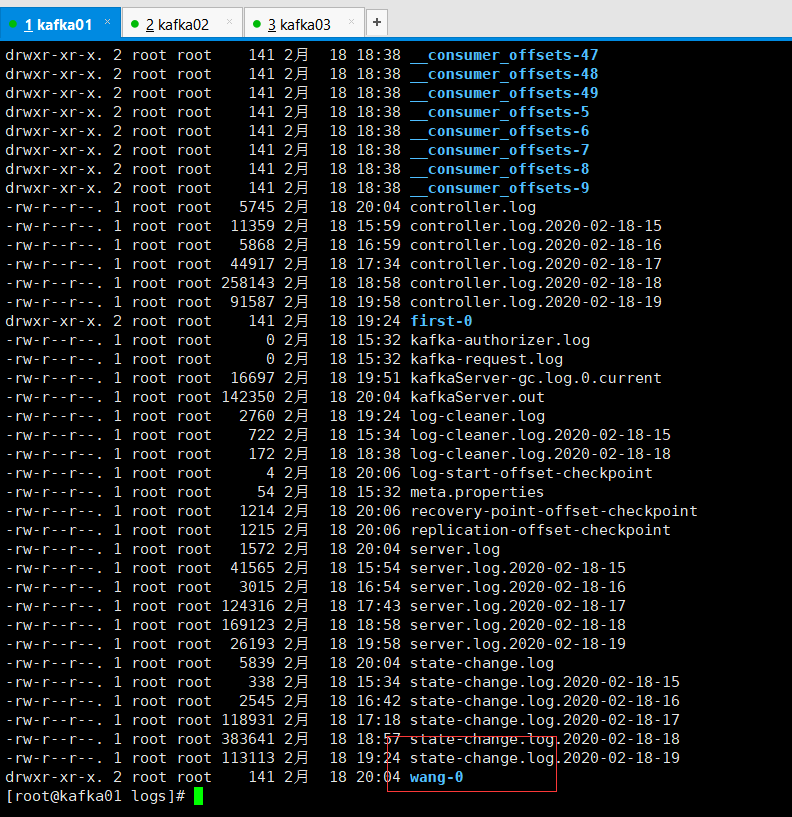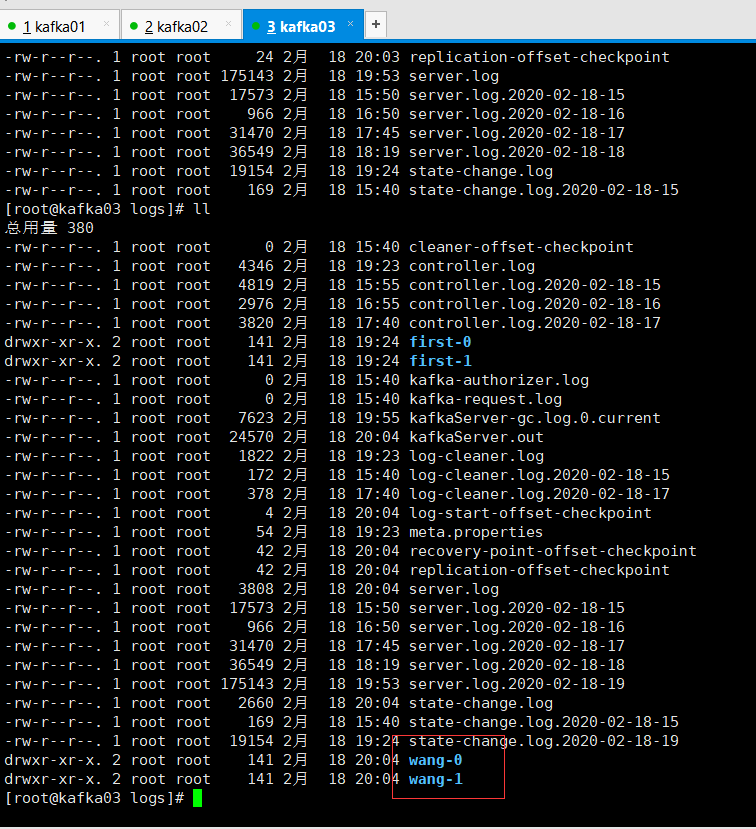安装zookeeper
步骤一:使用【rz】命令将zookeeper压缩包上传到【/opt/module】目录下

步骤二:使用【tar -zxvf zookeeper-3.4.6.tar.gz】命令解压文件

步骤三:进入【conf】目录,将【zoo_sample.cfg】文件复制为zoo.cfg文件(必须是这个文件名)
cp zoo_sample.cfg zoo.cfg
步骤四:使用【vim zoo.cfg】命令对文件进行编辑
dataDir=/tmp/zookeeper/data dataLogDir=/tmp/zookeeper/log
#配置集群添加如下配置
server.1=192.168.138.55:2888:3888 server.2=192.168.138.66:2888:3888 server.3=192.168.138.77:2888:3888

步骤五:在tmp目录下创建目录
mkdir /tmp/zookeeper
mkdir /tmp/zookeeper/data
mkdir /tmp/zookeeper/log
步骤六:如果是配置集群,还需要在【/tmp/zookeeper/data】目录下新增【myid】文件
cd /tmp/zookeeper/data
touch myid
vim myid
在【myid】文件中,修改对应的IP的机器上输入对应的编号。
如果在192.168.138.55,那么文件内容就是1;在192.168.138.66,那么文件内容就是2;
步骤七:配置环境变量
export ZOOKEEPER_INSTALL=/opt/module/zookeeper-3.4.6/
步骤八:启动zookeeper
cd /opt/module/zookeeper-3.4.6/bin
./zkServer.sh start
如果启动后结尾出现【STARTED】就代表启动成功
安装kafka
步骤一:使用【rz】命令将kafka压缩包上传到【/opt/module】目录下
步骤二:使用【tar -zxvf kafka_2.11-0.11.0.0.tgz】命令解压文件
步骤四:使用【mkdir logs】命令创建文件夹
步骤五:进入【config】目录,修改【server.properties】文件
# Licensed to the Apache Software Foundation (ASF) under one or more # contributor license agreements. See the NOTICE file distributed with # this work for additional information regarding copyright ownership. # The ASF licenses this file to You under the Apache License, Version 2.0 # (the "License"); you may not use this file except in compliance with # the License. You may obtain a copy of the License at # # http://www.apache.org/licenses/LICENSE-2.0 # # Unless required by applicable law or agreed to in writing, software # distributed under the License is distributed on an "AS IS" BASIS, # WITHOUT WARRANTIES OR CONDITIONS OF ANY KIND, either express or implied. # See the License for the specific language governing permissions and # limitations under the License. # see kafka.server.KafkaConfig for additional details and defaults ############################# Server Basics ############################# # The id of the broker. This must be set to a unique integer for each broker. broker.id=1 # Switch to enable topic deletion or not, default value is false delete.topic.enable=true ############################# Socket Server Settings ############################# # The address the socket server listens on. It will get the value returned from # java.net.InetAddress.getCanonicalHostName() if not configured. # FORMAT: # listeners = listener_name://host_name:port # EXAMPLE: # listeners = PLAINTEXT://your.host.name:9092 listeners=PLAINTEXT://192.168.138.77:9092 # Hostname and port the broker will advertise to producers and consumers. If not set, # it uses the value for "listeners" if configured. Otherwise, it will use the value # returned from java.net.InetAddress.getCanonicalHostName(). #advertised.listeners=PLAINTEXT://your.host.name:9092 # Maps listener names to security protocols, the default is for them to be the same. See the config documentation for more details #listener.security.protocol.map=PLAINTEXT:PLAINTEXT,SSL:SSL,SASL_PLAINTEXT:SASL_PLAINTEXT,SASL_SSL:SASL_SSL # The number of threads that the server uses for receiving requests from the network and sending responses to the network num.network.threads=3 # The number of threads that the server uses for processing requests, which may include disk I/O num.io.threads=8 # The send buffer (SO_SNDBUF) used by the socket server socket.send.buffer.bytes=102400 # The receive buffer (SO_RCVBUF) used by the socket server socket.receive.buffer.bytes=102400 # The maximum size of a request that the socket server will accept (protection against OOM) socket.request.max.bytes=104857600 ############################# Log Basics ############################# # A comma seperated list of directories under which to store log files log.dirs=/opt/module/kafka/logs # The default number of log partitions per topic. More partitions allow greater # parallelism for consumption, but this will also result in more files across # the brokers. num.partitions=1 # The number of threads per data directory to be used for log recovery at startup and flushing at shutdown. # This value is recommended to be increased for installations with data dirs located in RAID array. num.recovery.threads.per.data.dir=1 ############################# Internal Topic Settings ############################# # The replication factor for the group metadata internal topics "__consumer_offsets" and "__transaction_state" # For anything other than development testing, a value greater than 1 is recommended for to ensure availability such as 3. offsets.topic.replication.factor=1 transaction.state.log.replication.factor=1 transaction.state.log.min.isr=1 ############################# Log Flush Policy ############################# # Messages are immediately written to the filesystem but by default we only fsync() to sync # the OS cache lazily. The following configurations control the flush of data to disk. # There are a few important trade-offs here: # 1. Durability: Unflushed data may be lost if you are not using replication. # 2. Latency: Very large flush intervals may lead to latency spikes when the flush does occur as there will be a lot of data to flush. # 3. Throughput: The flush is generally the most expensive operation, and a small flush interval may lead to exceessive seeks. # The settings below allow one to configure the flush policy to flush data after a period of time or # every N messages (or both). This can be done globally and overridden on a per-topic basis. # The number of messages to accept before forcing a flush of data to disk #log.flush.interval.messages=10000 # The maximum amount of time a message can sit in a log before we force a flush #log.flush.interval.ms=1000 ############################# Log Retention Policy ############################# # The following configurations control the disposal of log segments. The policy can # be set to delete segments after a period of time, or after a given size has accumulated. # A segment will be deleted whenever *either* of these criteria are met. Deletion always happens # from the end of the log. # The minimum age of a log file to be eligible for deletion due to age log.retention.hours=168 # A size-based retention policy for logs. Segments are pruned from the log as long as the remaining # segments don't drop below log.retention.bytes. Functions independently of log.retention.hours. #log.retention.bytes=1073741824 # The maximum size of a log segment file. When this size is reached a new log segment will be created. log.segment.bytes=1073741824 # The interval at which log segments are checked to see if they can be deleted according # to the retention policies log.retention.check.interval.ms=300000 ############################# Zookeeper ############################# # Zookeeper connection string (see zookeeper docs for details). # This is a comma separated host:port pairs, each corresponding to a zk # server. e.g. "127.0.0.1:3000,127.0.0.1:3001,127.0.0.1:3002". # You can also append an optional chroot string to the urls to specify the # root directory for all kafka znodes. zookeeper.connect=192.168.138.55:2181,192.168.138.66:2181,192.168.138.77:2181 # Timeout in ms for connecting to zookeeper zookeeper.connection.timeout.ms=6000 ############################# Group Coordinator Settings ############################# # The following configuration specifies the time, in milliseconds, that the GroupCoordinator will delay the initial consumer rebalance. # The rebalance will be further delayed by the value of group.initial.rebalance.delay.ms as new members join the group, up to a maximum of max.poll.interval.ms. # The default value for this is 3 seconds. # We override this to 0 here as it makes for a better out-of-the-box experience for development and testing. # However, in production environments the default value of 3 seconds is more suitable as this will help to avoid unnecessary, and potentially expensive, rebalances during application startup.
broker.id=1 #每个主机的id不能相同
listeners=PLAINTEXT://192.168.138.77:9092 #此值集群是一定要配本机IP,否则会被识别为localhost
advertised.listeners=PLAINTEXT://192.168.138.77:9092 #此值集群是一定要配本机IP,否则会被识别为localhost
log.dirs=/opt/module/kafka/logs #存放主题的 相关的topic内容
zookeeper.connect=192.168.138.55:2181,192.168.138.66:2181,192.168.138.77:2181 #zookeeper集群地址
【修改完成后,每个主机的server.properties文件都要修改】
步骤六:启动kafka
cd /work/kafka_2.11-0.10.2.0
bin/kafka-server-start.sh -daemon config/server.properties
此种方式启动kafka日志不会直接打印到控制台
kafka+zookeeper测试
步骤一:创建topic
bin/kafka-topics.sh --create --zookeeper 192.168.138.55:2181,192.168.138.66:2181,192.168.138.77:2181 --replication-factor 2 --partitions 2 --topic first
--topic first:表示是定义的名称
--replication-factor:定义的副本数
--partitions:定义的区分数
注意:这里创建的topic每个主机中都会有相应的topic
kafka01:

kafka02:

kafka03:

步骤二:查看topic
bin/kafka-topics.sh --describe --zookeeper 192.168.138.55:2181,192.168.138.66:2181,192.168.138.77:2181 --topic wang
步骤三:创建生产者
bin/kafka-console-producer.sh --broker-list 192.168.138.55:9092,192.168.138.66:9092,192.168.138.77:9092 --topic wang
步骤四:创建消费者
bin/kafka-console-consumer.sh --bootstrap-server 192.168.138.55:9092,192.168.138.66:9092,192.168.138.77:9092 --topic wang --from-beginning

步骤五:删除topic
bin/kafka-topics.sh --zookeeper 192.168.138.55:2181,192.168.138.66:2181,192.169.138.77:2181 --delete --topic wang

删除完成后可以在logs目录下查询对应的topic是否存在
步骤六:关闭kafka
bin/kafka-server-stop.sh conf/server.properties
步骤七:关闭zookeeper
bin/zkServer.sh stop conf/zoo.cfg
注意事项
1.启动kafka过一会进程自动挂掉问题原因
这是因为kafka logs目录下的meta.properties文件中的broker.id与server.properties中的broker.id不一致所导致,只需把两者改为一致启动kafka后就不会自动挂掉了

2.用Kafka创建topic时报错:Exception in thread "main" org.I0Itec.zkclient.exception.ZkTimeoutException: Unable to connect to zookeeper server within timeout: 30000
现原因:多样,比如kafka没启动,服务器时间不同,防火墙没关。(下面的解决办法只供参考)
解决办法:
1、启动kafka。
3、关闭防火墙。
